Further Development of Gasoline from the bioliq® Process with Focus on Particulate and Hydrocarbon Emissions
Abstract
:1. Introduction
2. Fuel Production and Properties
2.1. Further Development of the bioliq® Product Refinement
2.2. Comparison of Fuel Characteristics
3. Measurement Setup
3.1. Engine and Emission Measurement Setup
3.2. Pressure Chamber
4. Results and Discussion
4.1. Spray Analysis
4.2. Particulate Emissions
4.3. Particulate Size Distribution
4.4. Hydrocarbons
5. Conclusions
- Measurement of the spray characteristics at showed decreasing atomization with increasing bioliq® fuel content, partly due to the lower vapor pressure of the bioliq® 2019 fuel. Increasing the pressure to resulted in a leveling of the spray characteristics due generally to less flash-boiling.
- The reduction in heavy aromatics results in a direct reduction in the particulate number concentration in the case of all investigated blends.
- By adding bioliq® fuel to the base fuel, an increase in the particulate diameter can be observed at low engine loads. This effect is distinguished at higher engine loads; thus, no significant difference between the base fuel and the blends can be observed.
- The hydrocarbon emissions were significantly reduced. At injection timings close to the optimized conditions for low hydrocarbon emissions, the addition of bioliq® fuel did not lead to a deterioration in emission formation. Only for later timed injections, accompanied by shorter time of mixture formation, hydrocarbon emissions also increased with higher bioliq® fuel content. However, compared to the bioliq®/10 2017 fuel, the percentage of renewably produced hydrocarbons could be doubled in a blend with 20 bioliq® fuel.
Author Contributions
Funding
Acknowledgments
Conflicts of Interest
Abbreviations
| AFR | Air–fuel ratio |
| BtL | Biomass-to-liquids |
| CAbTDCf | Crank angle before top dead center firing |
| DI | Direct injection |
| Detection limit of the FID | |
| DME | Dimethyl ether |
| DtG | Dimethyl ether-to-Gasoline |
| EEPS | Engine Exhaust Particle Sizer |
| EN | European standard |
| ETBE | Ethyl tertiary-butyl ether |
| EU | European Union |
| FID | Flame ionization detector |
| GPF | Gasoline particulate filter |
| h | Operation time after last analyzer calibration |
| HC | Hydrocarbons |
| HS | High-speed |
| IMEP | Indicated mean effective pressure |
| KIT | Karlsruhe Institute of Technology |
| LED | Light-emitting diode |
| MON | Motor octane number |
| Measured value of hydrocarbon concentration | |
| PSD | Particulate size distribution |
| RED | Renewable Energy Directive |
| RON | Research octane number |
| SI | Spark-ignited |
| SOI | Start of injection |
| Uncertainty of hydrocarbon concentration measurement |
References
- United Nations. Sustainable Transport, Sustainable Development. Interagency Report for Second Global Sustainable Transport Conference; United Nations: San Francisco, CA, USA, 2021. [Google Scholar]
- Dinjus, E.; Arnold, U.; Dahmen, N.; Höfer, R.; Wach, W. Chapter 8. Green Fuels—Sustainable Solutions for Transportation. In Sustainable Solutions for Modern Economies; Green Chemistry Series; Hofer, R., Ed.; Royal Society of Chemistry: Cambridge, UK, 2009; Volume 4, pp. 125–163. [Google Scholar] [CrossRef]
- European Parliament and the Council. Directive (EU) 2018/2001 of the European Parliament and of the Council of 11 December 2018 on the Promotion of the Use of Energy from Renewable Sources (Recast); EUR-Lex: Brussels, Belgium, 2018. [Google Scholar]
- Dinjus, E.; Dahmen, N. Das bioliq®-Verfahren Konzept, Technologie und Stand der Entwicklung. Mot. Z. 2010, 71, 864–868. [Google Scholar] [CrossRef]
- Dahmen, N.; Dinjus, E.; Kolb, T.; Arnold, U.; Leibold, H.; Stahl, R. State of the art of the bioliq® process for synthetic biofuels production. Environ. Prog. Sustain. Energy 2012, 31, 176–181. [Google Scholar] [CrossRef]
- Dahmen, N.; Abeln, J.; Eberhard, M.; Kolb, T.; Leibold, H.; Sauer, J.; Stapf, D.; Zimmerlin, B. The bioliq® process for producing synthetic transportation fuels. WIREs Energy Environ. 2017, 6, 425. [Google Scholar] [CrossRef]
- Keil, F.J. Methanol-to-hydrocarbons: Process technology. Microporous Mesoporous Mater. 1999, 29, 49–66. [Google Scholar] [CrossRef]
- Eckert, P.; Eichlseder, H.; Rakowski, S.; Tschöke, H. Brennstoffe. In Grundlagen Verbrennungsmotoren; Merker, G.P., Teichmann, R., Eds.; Springer Fachmedien Wiesbaden: Wiesbaden, Germany, 2019; Volume 1, pp. 541–573. [Google Scholar] [CrossRef]
- Karavalakis, G.; Short, D.; Vu, D.; Russell, R.; Hajbabaei, M.; Asa-Awuku, A.; Durbin, T.D. Evaluating the Effects of Aromatics Content in Gasoline on Gaseous and Particulate Matter Emissions from SI-PFI and SIDI Vehicles. Environ. Sci. Technol. 2015, 49, 7021–7031. [Google Scholar] [CrossRef]
- Michler, T.; Wippermann, N.; Toedter, O.; Niethammer, B.; Otto, T.; Arnold, U.; Pitter, S.; Koch, T.; Sauer, J. Gasoline from the bioliq® process: Production, characterization and performance. Fuel Process. Technol. 2020, 206, 106476. [Google Scholar] [CrossRef]
- Said, Z.; Le, D.T.N.; Sharma, P.; Dang, V.H.; Le, H.S.; Nguyen, D.T.; Bui, T.A.E.; van Nguyen, G. Optimization of combustion, performance, and emission characteristics of a dual-fuel diesel engine powered with microalgae-based biodiesel/diesel blends and oxyhydrogen. Fuel 2022, 326, 124987. [Google Scholar] [CrossRef]
- Sharma, P.; Le, M.P.; Chhillar, A.; Said, Z.; Deepanraj, B.; Cao, D.N.; Bandh, S.A.; Hoang, A.T. Using response surface methodology approach for optimizing performance and emission parameters of diesel engine powered with ternary blend of Solketal-biodiesel-diesel. Sustain. Energy Technol. Assessments 2022, 52, 102343. [Google Scholar] [CrossRef]
- Park, S.H.; Kim, H.J.; Suh, H.K.; Lee, C.S. Atomization and spray characteristics of bioethanol and bioethanol blended gasoline fuel injected through a direct injection gasoline injector. Int. J. Heat Fluid Flow 2009, 30, 1183–1192. [Google Scholar] [CrossRef]
- Das, S.K.; Kim, K.; Lim, O. Experimental study on non-vaporizing spray characteristics of biodiesel-blended gasoline fuel in a constant volume chamber. Fuel Process. Technol. 2018, 178, 322–335. [Google Scholar] [CrossRef]
- Brem, B.T.; Durdina, L.; Siegerist, F.; Beyerle, P.; Bruderer, K.; Rindlisbacher, T.; Rocci-Denis, S.; Andac, M.G.; Zelina, J.; Penanhoat, O.; et al. Effects of Fuel Aromatic Content on Nonvolatile Particulate Emissions of an In-Production Aircraft Gas Turbine. Environ. Sci. Technol. 2015, 49, 13149–13157. [Google Scholar] [CrossRef] [PubMed]
- Short, D.Z.; Vu, D.; Durbin, T.D.; Karavalakis, G.; Asa-Awuku, A. Components of Particle Emissions from Light-Duty Spark-Ignition Vehicles with Varying Aromatic Content and Octane Rating in Gasoline. Environ. Sci. Technol. 2015, 49, 10682–10691. [Google Scholar] [CrossRef] [PubMed]
- Michler, T.; Dörnhöfer, J.; Erforth, D.; Heinz, A.; Scheiber, K.; Weber, P.; Nowak, N.; Kubach, H.; Meyer, J.; Koch, T.; et al. Comparison of Different Particle Measurement Techniques at a Heavy-Duty Diesel Engine Test Bed. In SAE International400 Commonwealth Drive; SAE Technical Paper Series; SAE International: Warrendale, PA, USA, 2019. [Google Scholar] [CrossRef]
- Wang, X.; Grose, M.A.; Caldow, R.; Osmondson, B.L.; Swanson, J.J.; Chow, J.C.; Watson, J.G.; Kittelson, D.B.; Li, Y.; Xue, J.; et al. Improvement of Engine Exhaust Particle Sizer (EEPS) size distribution measurement—II. Engine exhaust particles. J. Aerosol Sci. 2016, 92, 83–94. [Google Scholar] [CrossRef]
- Plaß, A.; Maliha, M.; Kubach, H.; Koch, T. Spray characterization of DMC and MeFo on multi-hole injectors for highly boosted DISI combustion engines. Int. J. Engine Res. 2021, 6, 146808742110381. [Google Scholar] [CrossRef]
- Wen, L.B.; Xin, C.Y.; Yang, S.C. The effect of adding dimethyl carbonate (DMC) and ethanol to unleaded gasoline on exhaust emission. Appl. Energy 2010, 87, 115–121. [Google Scholar] [CrossRef]
- Matsumoto, A.; Zheng, Y.; Xie, X.B.; Lai, M.C.; Moore, W. Characterization of Multi-hole Spray and Mixing of Ethanol and Gasoline Fuels under DI Engine Conditions. In SAE International400 Commonwealth Drive; SAE Technical Paper Series; SAE International: Warrendale, PA, USA, 2010. [Google Scholar] [CrossRef]
- Zeng, W.; Xu, M.; Zhang, G.; Zhang, Y.; Cleary, D.J. Atomization and vaporization for flash-boiling multi-hole sprays with alcohol fuels. Fuel 2012, 95, 287–297. [Google Scholar] [CrossRef]
- Xu, M.; Zhang, Y.; Zeng, W.; Zhang, G.; Zhang, M. Flash Boiling: Easy and Better Way to Generate Ideal Sprays than the High Injection Pressure. SAE Int. J. Fuels Lubr. 2013, 6, 137–148. [Google Scholar] [CrossRef]
- Zeng, W.; Xu, M.; Zhang, M.; Zhang, Y.; Cleary, D.J. Macroscopic characteristics for direct-injection multi-hole sprays using dimensionless analysis. Exp. Therm. Fluid Sci. 2012, 40, 81–92. [Google Scholar] [CrossRef]
- Hu, J.; Liu, B.; Zhang, C.; Gao, H.; Zhao, Z.; Zhang, F.; Wang, Y. Experimental study on the spray characteristics of an air-assisted fuel injection system using kerosene and gasoline. Fuel 2019, 235, 782–794. [Google Scholar] [CrossRef]
- Bertsch, M.; Koch, T.; Velji, A. Influence of charge motion and injection pressure on the particulate emission of a gasoline DI-SI engine at homogeneous, boosted operation. SIA-Société des Ingénieurs de Lautomobile (ed.). In Proceedings of the SIA Powertrain: The Low CO2 Spark Ignition Engine The low CO2 Spark Ignition Engine of the Future and its Hybridization, Versailles, France, 27–28 May 2015. [Google Scholar]
- Dageförde, H. Untersuchung Innermotorischer Einflussgrößen auf die Partikelemission eines Ottomotors mit Direkteinspritzung. Ph.D. Thesis, Karlsruhe Institute of Technology, Karlsruhe, Germany, 2015. [Google Scholar] [CrossRef]
- Bertsch, M. Experimental Investigations on Particle Number Emissions from GDI Engines. Ph.D. Thesis, Karlsruhe Institute of Technology, Karlsruhe, Germany, 2016. [Google Scholar] [CrossRef]
- Wiese, W.; Laidig, C.; Schünemann, E.; Balthasar, F.; Cahal, J. Effects of Fuel Composition, Additives and Injection Parameters on Particulate Formation of Gasoline DI Engines. In Proceedings of the 39th International Vienna Motor Symposium, Vienna, Austria, 26–27 April 2018; Geringer, B., Lenz, H.P., Eds.; VDI Verlag: Düsseldorf, Germany, 2018; Volume 2, pp. 556–574. [Google Scholar] [CrossRef]
- Tahtouh, T.; Ben Amara, A.; Anselmi, P.; Starck, L. Impact of Ethanol and Aromatic Hydrocarbons on Particulate Emissions from a Gasoline Vehicle. In SAE International400 Commonwealth Drive; SAE Technical Paper Series; SAE International: Warrendale, PA, USA, 2019. [Google Scholar] [CrossRef]
- Fatouraie, M.; Frommherz, M.; Mosburger, M.; Chapman, E.; Li, S.; McCormick, R.; Fioroni, G. Investigation of the Impact of Fuel Properties on Particulate Number Emission of a Modern Gasoline Direct Injection Engine. In SAE International400 Commonwealth Drive; SAE Technical Paper Series; SAE International: Warrendale, PA, USA, 2018. [Google Scholar] [CrossRef]
- Leach, F.; Knorsch, T.; Laidig, C.; Wiese, W. A Review of the Requirements for Injection Systems and the Effects of Fuel Quality on Particulate Emissions from GDI Engines. In SAE International400 Commonwealth Drive; SAE Technical Paper Series; SAE International: Warrendale, PA, USA, 2018. [Google Scholar] [CrossRef]
- Zhang, W.; Ma, X.; Shuai, S.; Wu, K.; Macias, J.R.; Shen, Y.; Yang, C.; Guan, L. Effect of gasoline aromatic compositions coupled with single and double injection strategy on GDI engine combustion and emissions. Fuel 2020, 278, 118308. [Google Scholar] [CrossRef]
- Liu, H.; Li, Z.; Zhang, M.; Xu, H.; Ma, X.; Shuai, S. Exhaust non-volatile particle filtration characteristics of three-way catalyst and influencing factors in a gasoline direct injection engine compared to gasoline particulate filter. Fuel 2021, 290, 120065. [Google Scholar] [CrossRef]
- Guo, D.; Ge, Y.; Wang, X.; Liu, H.; Su, S.; Li, C.; Tao, T. Evaluating the filtration efficiency of close-coupled catalyzed gasoline particulate filter (cGPF) over the WLTC and simulated RDE cycles. Chemosphere 2022, 301, 134717. [Google Scholar] [CrossRef] [PubMed]
- Fiebig, M.; Schönen, M.; Grütering, U.; Pischinger, S. Einflüsse motorischer Betriebsparameter auf die Reaktivität von Dieselruss. Mot. Z. 2010, 71, 524–531. [Google Scholar] [CrossRef]
- Massner, A.; Gärtner, U.; Koch, T. Die Reaktivität von Dieselruß und die Auswirkungen auf den Betrieb von Abgasnachbehandlungssystemen. In Proceedings of the 9 FAD Conference, Ludwigsburg, Germany, 3 October 2011. [Google Scholar]
- Yao, C.; Dou, Z.; Wang, B.; Liu, M.; Lu, H.; Feng, J.; Feng, L. Experimental study of the effect of heavy aromatics on the characteristics of combustion and ultrafine particle in DISI engine. Fuel 2017, 203, 290–297. [Google Scholar] [CrossRef]
- Qian, Y.; Wang, J.; Li, Z.; Jiang, C.; He, Z.; Yu, L.; Lu, X. Improvement of combustion performance and emissions in a gasoline direct injection (GDI) engine by modulation of fuel volatility. Fuel 2020, 268, 117369. [Google Scholar] [CrossRef]

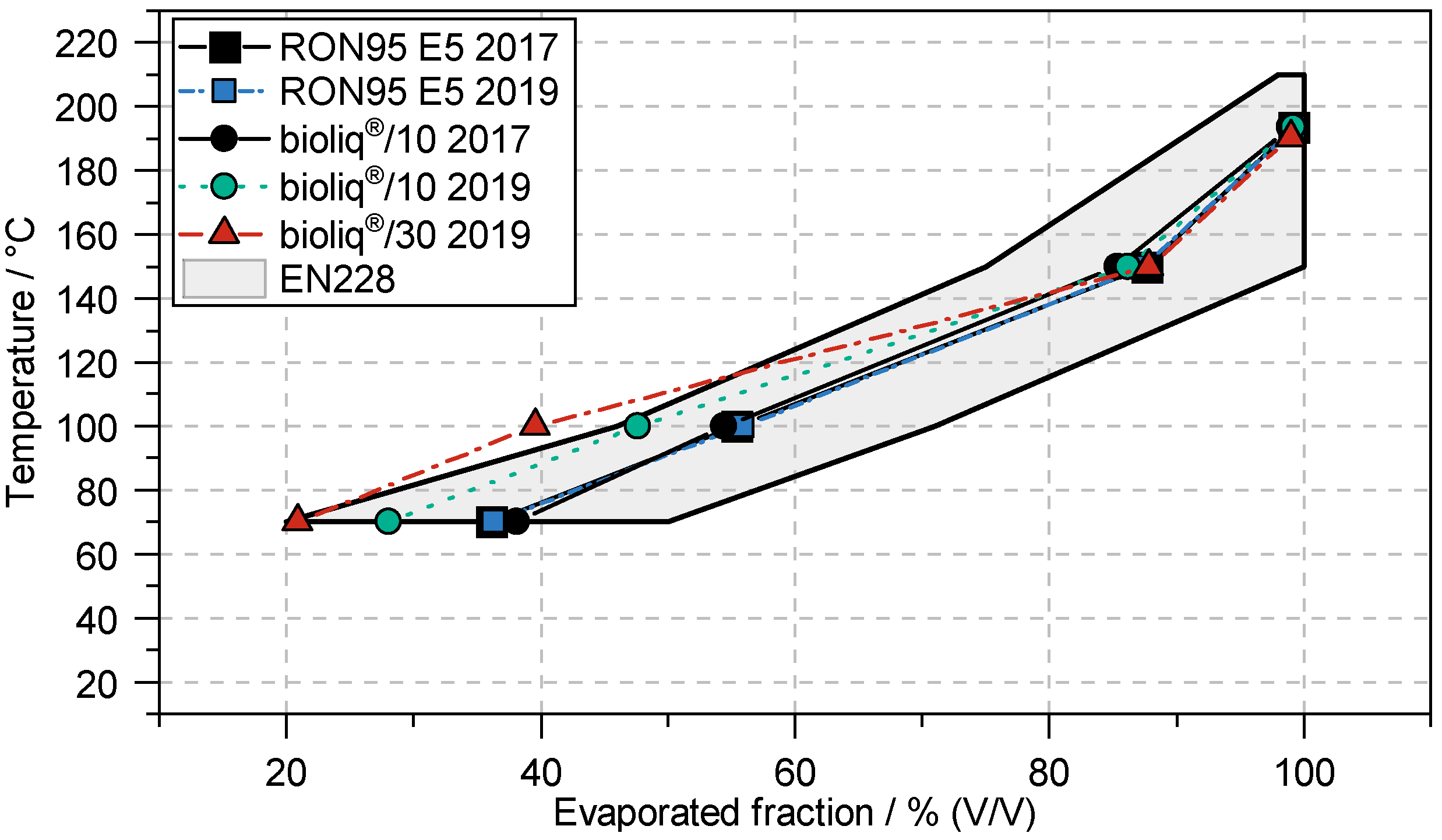
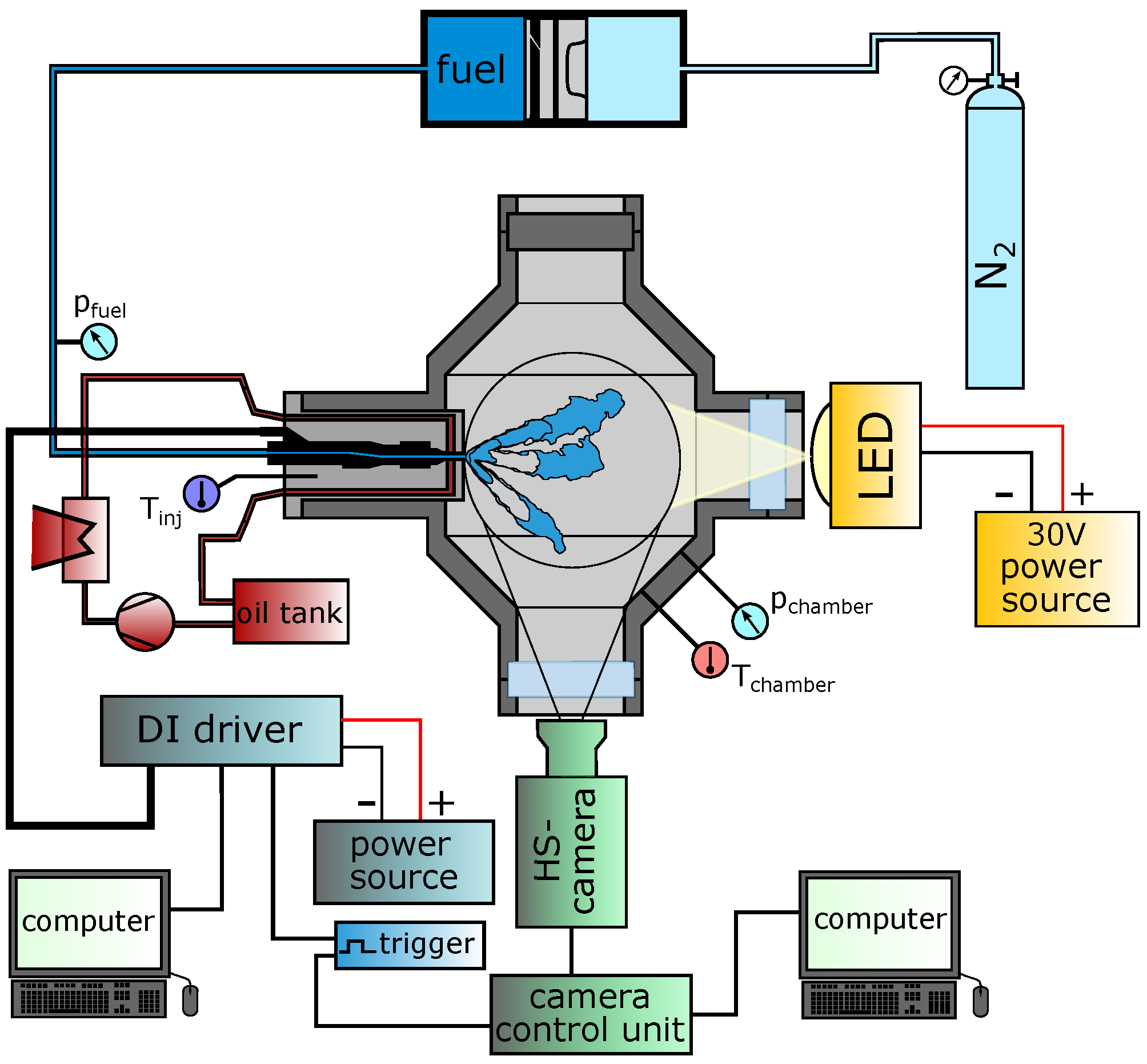
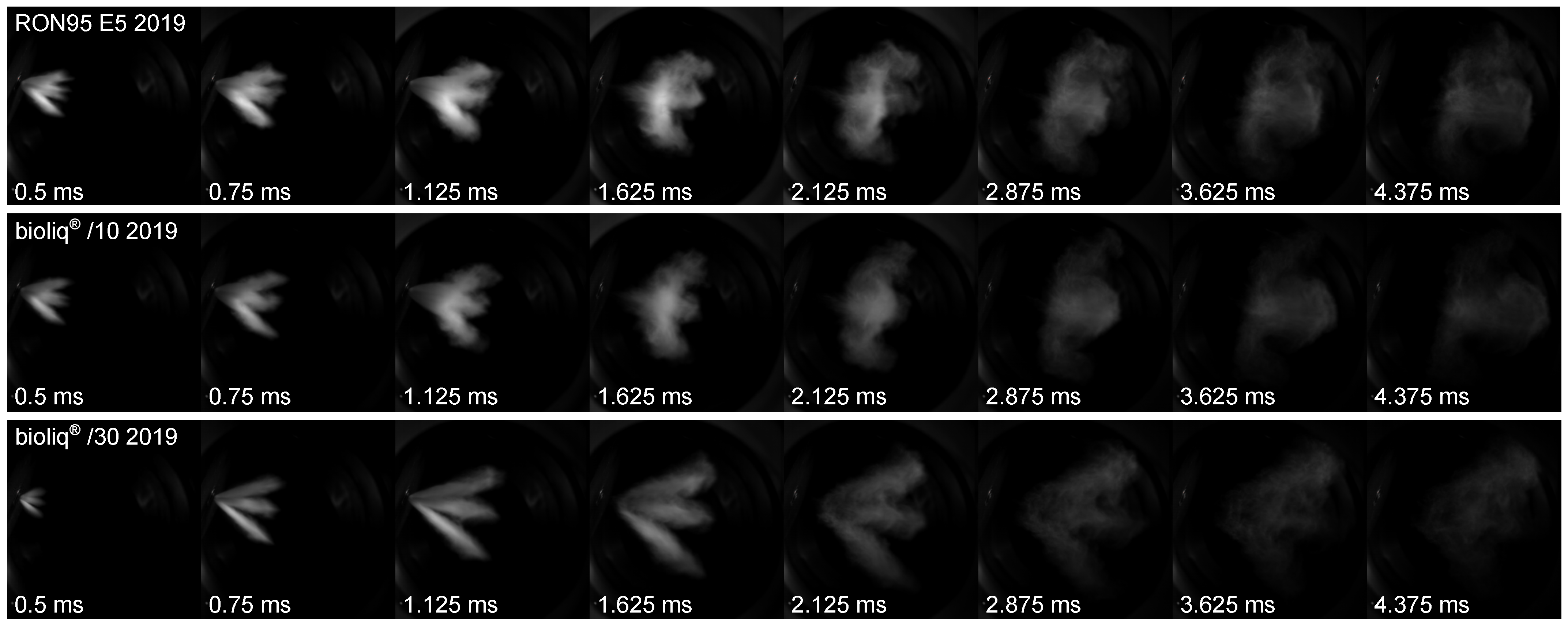

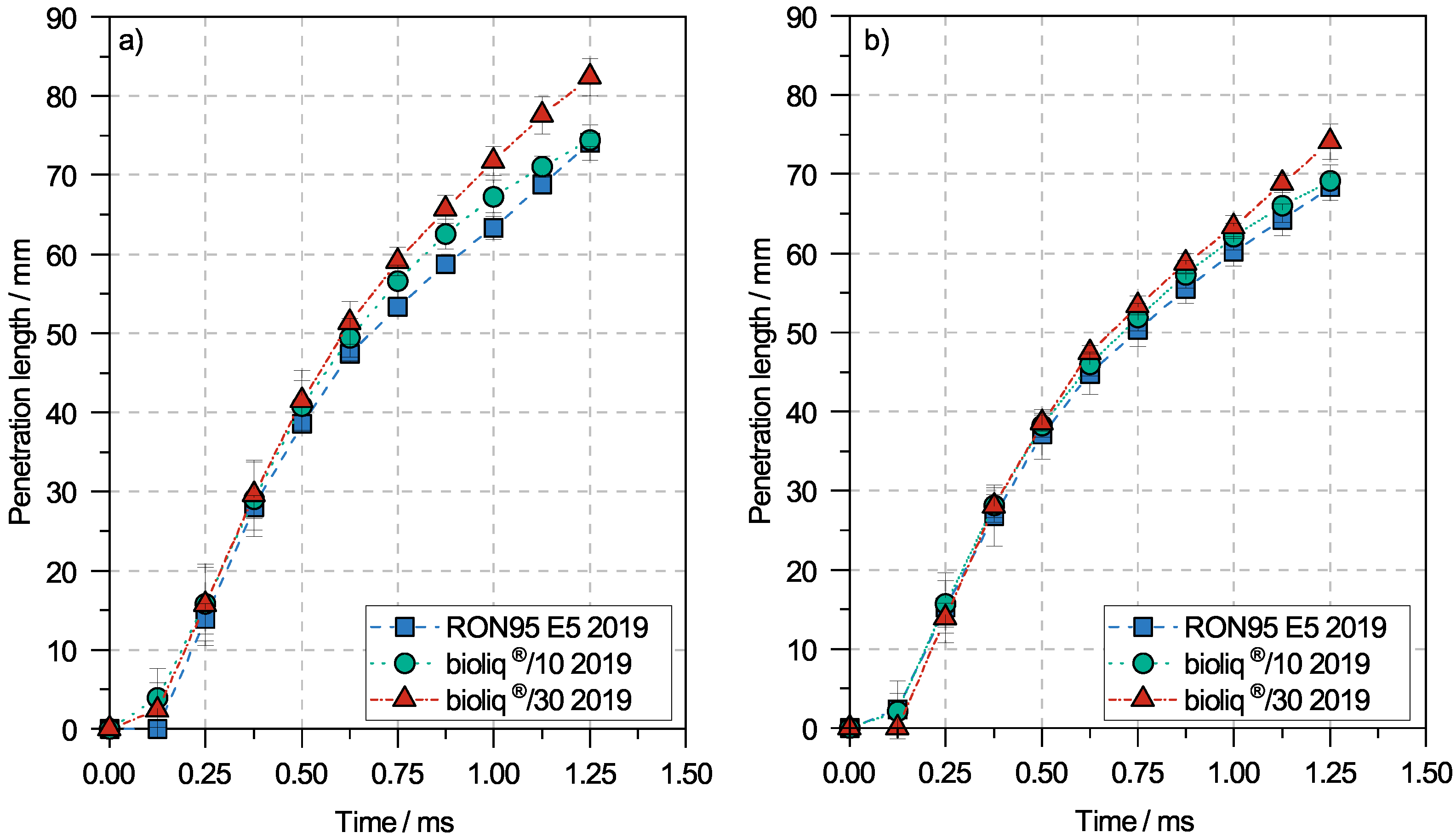
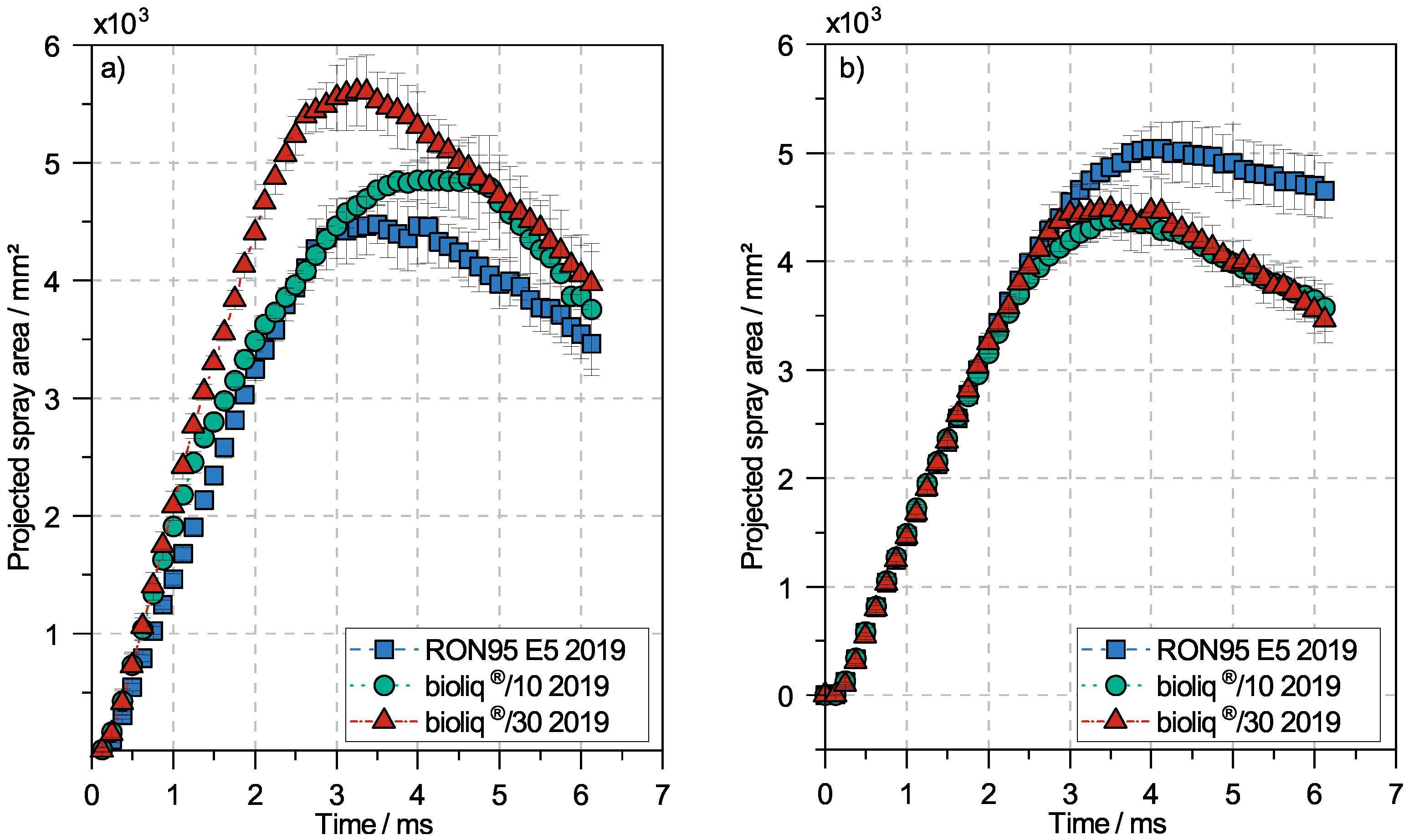

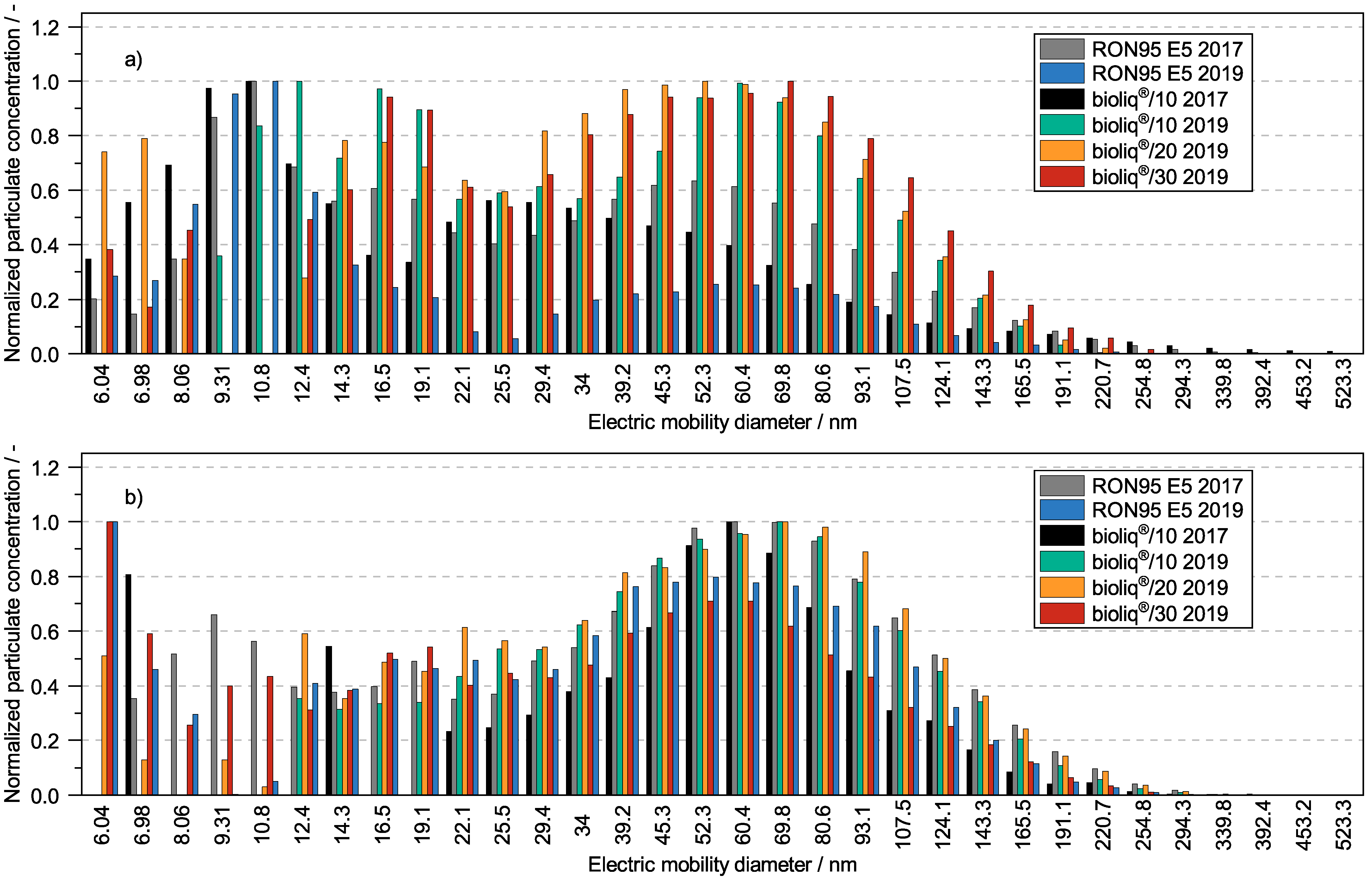
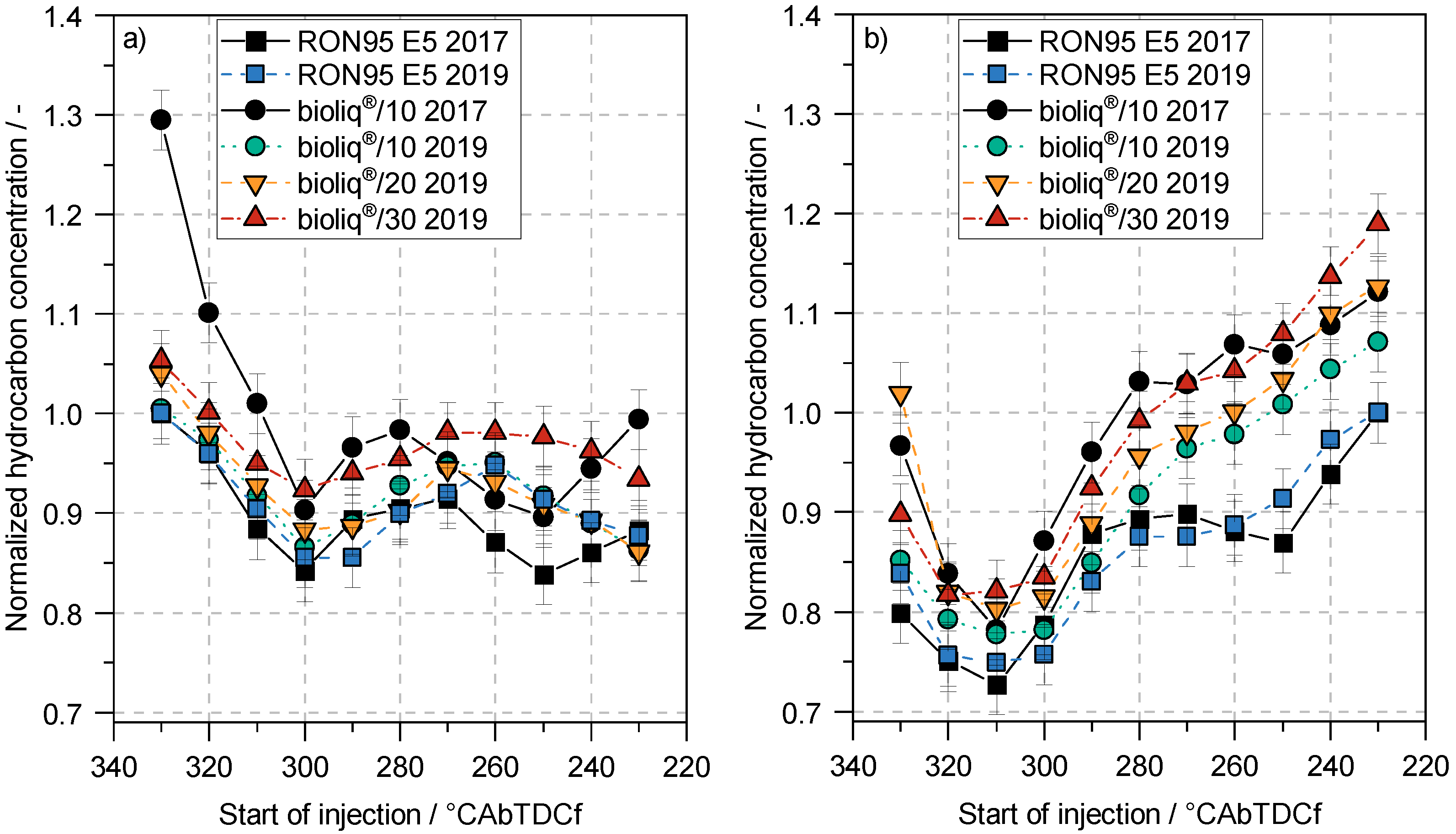
| Property | Unit | RON95 E5 2017 | bioliq®/10 2017 | RON95 E5 2019 | bioliq®/10 2019 | bioliq®/30 2019 | EN228 Limits | Method Used |
|---|---|---|---|---|---|---|---|---|
| RON | - | 95.6 | 96.4 | 95.1 | 96.0 | 97.2 | >95.0 | DIN EN ISO 5164:2014 |
| MON | - | 85.5 | 85.5 | 85.2 | 85.5 | 86.1 | >85.0 | DIN EN ISO 5163:2014 |
| Density at 15 | 740.6 | 747.0 | 747.5 | 751.7 | 772.2 | 720.0–775.0 | DIN EN ISO 12185:1997 | |
| End of boiling curve | 199.5 | 196.9 | 197.1 | 197.1 | 190.2 | <210.0 | DIN EN ISO 3405:2011 | |
| Distillation residue | 0.8 | 1.1 | 0.7 | 0.8 | 1.0 | <2.0 | DIN EN ISO 3405:2011 | |
| Vapor pressure | 63.8 | 74.1 | 56.4 | 53.3 | 49.2 | 45.0–90.0 | DIN EN 13016-1:2018 | |
| Sum oxygen | 1.9 | 1.8 | 1.9 | 1.6 | <1.5 | <2.7 | DIN EN ISO 22854:2016 | |
| Sum aromatics | 36.5 | 38.7 | 37.1 | 41.4 | 50.4 | <42.0 | DIN EN ISO 22854:2016 |
| Property | Value |
|---|---|
| Displaced volume/ | 498 |
| Stroke/ | 90 |
| Bore/ | 84 |
| Compression ratio/- | 10.5:1 |
| Injection system | Central-mounted DI |
| Rail pressure/ | 20 |
Disclaimer/Publisher’s Note: The statements, opinions and data contained in all publications are solely those of the individual author(s) and contributor(s) and not of MDPI and/or the editor(s). MDPI and/or the editor(s) disclaim responsibility for any injury to people or property resulting from any ideas, methods, instructions or products referred to in the content. |
© 2023 by the authors. Licensee MDPI, Basel, Switzerland. This article is an open access article distributed under the terms and conditions of the Creative Commons Attribution (CC BY) license (https://creativecommons.org/licenses/by/4.0/).
Share and Cite
Michler, T.; Niethammer, B.; Fuchs, C.; Toedter, O.; Arnold, U.; Koch, T.; Sauer, J. Further Development of Gasoline from the bioliq® Process with Focus on Particulate and Hydrocarbon Emissions. Fuels 2023, 4, 205-220. https://doi.org/10.3390/fuels4020013
Michler T, Niethammer B, Fuchs C, Toedter O, Arnold U, Koch T, Sauer J. Further Development of Gasoline from the bioliq® Process with Focus on Particulate and Hydrocarbon Emissions. Fuels. 2023; 4(2):205-220. https://doi.org/10.3390/fuels4020013
Chicago/Turabian StyleMichler, Tobias, Benjamin Niethammer, Constantin Fuchs, Olaf Toedter, Ulrich Arnold, Thomas Koch, and Jörg Sauer. 2023. "Further Development of Gasoline from the bioliq® Process with Focus on Particulate and Hydrocarbon Emissions" Fuels 4, no. 2: 205-220. https://doi.org/10.3390/fuels4020013
APA StyleMichler, T., Niethammer, B., Fuchs, C., Toedter, O., Arnold, U., Koch, T., & Sauer, J. (2023). Further Development of Gasoline from the bioliq® Process with Focus on Particulate and Hydrocarbon Emissions. Fuels, 4(2), 205-220. https://doi.org/10.3390/fuels4020013







